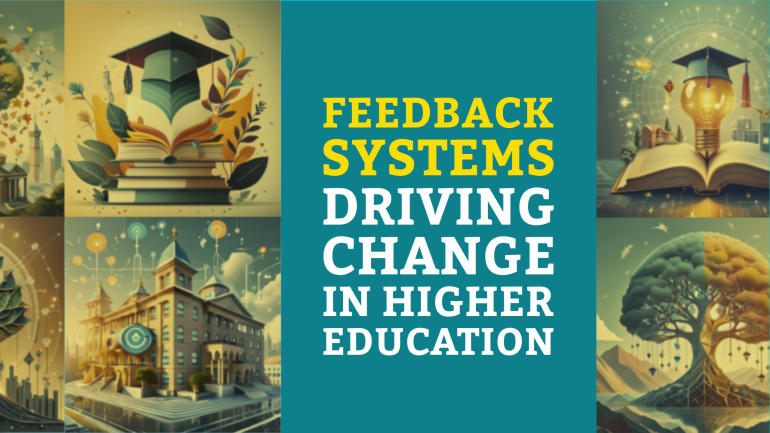Table of Contents
TL;DR: Feedback Systems – Driving Change in Higher Education
- Importance of Feedback Systems: Feedback systems play a crucial role in driving change in higher education by providing valuable insights and data for improving teaching methods and student learning outcomes.
- Continuous Improvement: By collecting feedback regularly, institutions can identify areas of strength and areas that need improvement, leading to continuous enhancement of the educational experience.
- Engagement and Accountability: Feedback systems promote engagement among students, faculty, and administrators, creating a culture of accountability and transparency within the academic community.
- Data-Informed Decision Making: Feedback data allows institutions to make informed decisions based on real-time inputs, leading to more effective strategies for curriculum development, student support, and institutional planning.
- Evolving with Technology: Leveraging technology for feedback systems enables higher education institutions to adapt to changing student needs, preferences, and learning environments, fostering innovation and growth within the sector.
There’s no denying the crucial role that feedback systems play in shaping the landscape of higher education today. As institutions strive to improve student outcomes, enhance teaching effectiveness, and promote institutional excellence, feedback mechanisms have emerged as powerful tools for driving positive change. However, without effective implementation and strategic utilization of feedback data, the potential benefits of these systems may go unrealized. In this blog post, we will explore the impact of feedback systems on shaping pedagogical approaches, enhancing student engagement, and ultimately transforming the higher education landscape.
Theoretical Framework for Feedback Systems
Principles of Effective Feedback
Systems of feedback in higher education must adhere to specific principles to ensure effectiveness. Constructive criticism delivered in a timely manner, with specific actionable steps for improvement, is crucial. The feedback should be goal-oriented and focused on the task at hand, promoting a growth mindset in receivers.
Models of Feedback in Educational Settings
Principles of feedback in educational settings encompass various models that guide the process. These models include the sandwich method, where constructive feedback is framed between positive commentary, and the Pendleton feedback model that emphasizes self-assessment before external evaluation.
Theoretical models provide a structured approach to implementing feedback systems, outlining the stages of the feedback process and the roles of both the provider and recipient. Understanding these models is crucial for designing feedback mechanisms that drive positive change and improvement in higher education institutions.
Feedback Systems and Technology Integration
Digital Platforms for Feedback Collection
Some of the most significant advancements in feedback systems for higher education have come from the integration of digital platforms for feedback collection. These platforms allow students to provide feedback in real-time, thereby enabling institutions to promptly address issues and enhance overall student experience.
Leveraging Data Analytics for Enhanced Feedback
To further improve feedback mechanisms, institutions are now leveraging data analytics to gain deeper insights into the feedback collected. By analyzing patterns and trends in feedback data, universities can identify areas for improvement, measure the impact of implemented changes, and make data-driven decisions to enhance teaching and learning experiences.
The integration of data analytics in feedback systems not only allows institutions to gain valuable insights but also enables them to proactively address issues before they escalate. By harnessing the power of data, universities can personalize educational experiences, track student progress, and continuously refine their teaching methodologies to meet the evolving needs of students.
Feedback Systems as Catalysts for Institutional Change
Case for Continuous Improvement in Academia
The landscape of higher education is evolving at a rapid pace, with changing student demographics, technological advancements, and global competition reshaping the sector. The need for continuous improvement in academia has never been more critical. Feedback systems play a pivotal role in facilitating this evolution by providing valuable insights into teaching effectiveness, curriculum relevance, and student satisfaction.
Overcoming Barriers to Implementing Feedback Systems
Barriers such as resistance to change, lack of resources, and fear of transparency can impede the successful implementation of feedback systems in higher education institutions. Overcoming these obstacles requires strong leadership commitment, clear communication strategies, and a culture that values data-driven decision-making.
Catalysts such as faculty buy-in, student engagement, and a robust feedback infrastructure can drive the successful adoption of feedback systems. By leveraging these catalysts, institutions can foster a culture of continuous improvement, enhance student learning outcomes, and stay ahead of the curve in a rapidly changing educational landscape.
The Impact of Feedback on Student Learning and Development
Enhancing Student Engagement through Feedback
After completing an assignment or assessment, students often await feedback eagerly. This feedback, whether provided by instructors or peers, plays a crucial role in enhancing student engagement with the course material. By offering constructive comments and suggestions for improvement, educators can motivate students to deepen their understanding, stay focused, and actively participate in their learning journey.
Preparing Students for the Real World with Constructive Feedback
An important component of higher education is preparing students for the challenges they will face in the professional world. Constructive feedback enables students to develop important skills such as critical thinking, problem-solving, and effective communication. By receiving timely and specific feedback on their work, students can learn to adapt to different situations, refine their approaches, and continuously strive for excellence.
With the increasing demand for adaptable and skilled graduates in today’s competitive job market, the ability to receive feedback gracefully and use it to drive personal and professional growth is invaluable. By embracing feedback as a tool for learning and development, students can cultivate a growth mindset, enhance their self-awareness, and become better equipped to succeed in their future careers.
Feedback Culture and Faculty Development
Professional Growth through Peer Review
Keep in mind that fostering a culture of feedback within higher education institutions is crucial for faculty development. Peer review mechanisms can be invaluable tools for professional growth. By engaging in peer reviews, faculty members can receive constructive criticism from their colleagues, leading to improvements in their teaching methods, research endeavors, and overall performance.
Aligning Faculty Incentives with Feedback Initiatives
With the growing emphasis on feedback systems, it is crucial to align faculty incentives with feedback initiatives. On the surface, this may seem challenging, but by linking feedback mechanisms to promotion opportunities, professional development programs, or performance evaluations, institutions can encourage faculty members to actively engage in the feedback process.
It is crucial to recognize that faculty buy-in is crucial for the success of any feedback initiative. By providing rewards for participation in feedback mechanisms, such as recognition, additional resources, or career advancement opportunities, institutions can motivate faculty members to actively participate and prioritize feedback in their professional development.
Best Practices in Designing and Managing Feedback Systems
Ensuring Anonymity and Ethical Considerations
For an effective feedback system in higher education, it is crucial to ensure anonymity and consider ethical implications. Students should feel confident that their feedback will not be traced back to them, encouraging honest and constructive responses. It is also necessary to adhere to ethical guidelines when collecting and using feedback data, respecting the privacy and rights of all individuals involved.
Strategies for Effective Communication of Feedback Results
Communication of feedback results plays a vital role in driving change in higher education institutions. Clear and concise reporting of feedback data to relevant stakeholders such as faculty members, administrators, and students is necessary. Effective communication ensures that the feedback is understood, analyzed, and acted upon to enhance teaching and learning experiences. Timely dissemination of results and actionable recommendations further facilitate the implementation of necessary changes.
Ensuring open communication channels for further discussion and feedback on the feedback results can also foster a culture of continuous improvement within the institution.
To wrap up
Conclusively, feedback systems play a crucial role in driving change in higher education by providing valuable insights into student performance, learning outcomes, and overall system effectiveness. By collecting, analyzing, and acting upon feedback from various stakeholders, institutions can continuously improve their programs, policies, and practices to better meet the needs and expectations of students. It is imperative for educators and administrators to embrace feedback systems as an vital tool for enhancing the quality of higher education and fostering a culture of continuous improvement. Incorporating feedback mechanisms into decision-making processes can lead to positive reforms, increased accountability, and ultimately, a more responsive and student-centered higher education system.
FAQ
Q: What are feedback systems in higher education?
A: Feedback systems in higher education are mechanisms put in place to collect, analyze, and utilize feedback from students, faculty, and other stakeholders to drive positive change and improvement in academic programs and services.
Q: Why are feedback systems important in higher education?
A: Feedback systems are crucial in higher education as they provide valuable insights into the effectiveness of educational practices, student satisfaction, and areas needing improvement. They help institutions make data-driven decisions to enhance the overall learning experience.
Q: How do feedback systems benefit students?
A: Feedback systems benefit students by giving them a platform to voice their opinions, concerns, and suggestions. This input can lead to improvements in teaching methods, course content, support services, and overall student experience, ultimately enhancing their academic journey.
Q: How can faculty members use feedback systems to improve their teaching?
A: Faculty members can use feedback systems to gather input from students on various aspects of their teaching, such as clarity of instruction, engagement strategies, and assessment methods. This feedback can help instructors make adjustments to their teaching practices and create a more effective learning environment.
Q: What are some best practices for implementing feedback systems in higher education?
A: Some best practices for implementing feedback systems in higher education include ensuring anonymity for respondents, collecting feedback at multiple touchpoints throughout a student’s academic journey, communicating transparently about the feedback process, and most importantly, using the feedback data to drive meaningful and actionable change within the institution.





